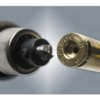Neck tension in units of diameter difference between die neck diameter and loaded round case neck outside, or sized case mouth and bullet diameters, is easier to comprehend by most people than the industry standard of bullet pull or extraction force in pounds is needed to overcome the case neck grip and friction on the bullet to push it out of the case neck.“Neck tension” is a term used in the hand loading community for the diametral fit between the bullet OD and case neck ID. Control is usually via sizing the case neck OD. Many would say that a round comprised of a case having a neck ID that is .001” less than the bullet OD has .001” of “neck tension.”
Depending on the amount of friction between bullet and case neck, plus how hard or soft the case neck brass is, a given dimension of neck tension will require different amounts of force to push the bullet out.
That said, "neck tension" dimensions works good enough for most people.
Last edited:












